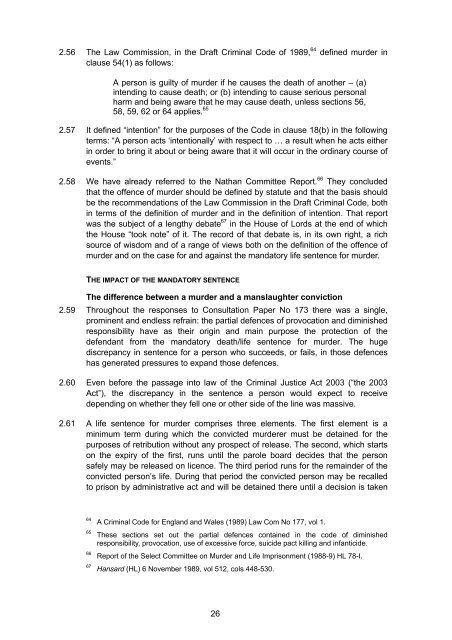lc290 Partial Defences to Murder report - Law Commission
lc290 Partial Defences to Murder report - Law Commission
lc290 Partial Defences to Murder report - Law Commission
You also want an ePaper? Increase the reach of your titles
YUMPU automatically turns print PDFs into web optimized ePapers that Google loves.
2.56 The <strong>Law</strong> <strong>Commission</strong>, in the Draft Criminal Code of 1989, 64 defined murder in<br />
clause 54(1) as follows:<br />
A person is guilty of murder if he causes the death of another – (a)<br />
intending <strong>to</strong> cause death; or (b) intending <strong>to</strong> cause serious personal<br />
harm and being aware that he may cause death, unless sections 56,<br />
58, 59, 62 or 64 applies. 65<br />
2.57 It defined “intention” for the purposes of the Code in clause 18(b) in the following<br />
terms: “A person acts ‘intentionally’ with respect <strong>to</strong> … a result when he acts either<br />
in order <strong>to</strong> bring it about or being aware that it will occur in the ordinary course of<br />
events.”<br />
2.58 We have already referred <strong>to</strong> the Nathan Committee Report. 66 They concluded<br />
that the offence of murder should be defined by statute and that the basis should<br />
be the recommendations of the <strong>Law</strong> <strong>Commission</strong> in the Draft Criminal Code, both<br />
in terms of the definition of murder and in the definition of intention. That <strong>report</strong><br />
was the subject of a lengthy debate 67 in the House of Lords at the end of which<br />
the House “<strong>to</strong>ok note” of it. The record of that debate is, in its own right, a rich<br />
source of wisdom and of a range of views both on the definition of the offence of<br />
murder and on the case for and against the manda<strong>to</strong>ry life sentence for murder.<br />
THE IMPACT OF THE MANDATORY SENTENCE<br />
The difference between a murder and a manslaughter conviction<br />
2.59 Throughout the responses <strong>to</strong> Consultation Paper No 173 there was a single,<br />
prominent and endless refrain: the partial defences of provocation and diminished<br />
responsibility have as their origin and main purpose the protection of the<br />
defendant from the manda<strong>to</strong>ry death/life sentence for murder. The huge<br />
discrepancy in sentence for a person who succeeds, or fails, in those defences<br />
has generated pressures <strong>to</strong> expand those defences.<br />
2.60 Even before the passage in<strong>to</strong> law of the Criminal Justice Act 2003 (“the 2003<br />
Act”), the discrepancy in the sentence a person would expect <strong>to</strong> receive<br />
depending on whether they fell one or other side of the line was massive.<br />
2.61 A life sentence for murder comprises three elements. The first element is a<br />
minimum term during which the convicted murderer must be detained for the<br />
purposes of retribution without any prospect of release. The second, which starts<br />
on the expiry of the first, runs until the parole board decides that the person<br />
safely may be released on licence. The third period runs for the remainder of the<br />
convicted person’s life. During that period the convicted person may be recalled<br />
<strong>to</strong> prison by administrative act and will be detained there until a decision is taken<br />
64 A Criminal Code for England and Wales (1989) <strong>Law</strong> Com No 177, vol 1.<br />
65 These sections set out the partial defences contained in the code of diminished<br />
responsibility, provocation, use of excessive force, suicide pact killing and infanticide.<br />
66 Report of the Select Committee on <strong>Murder</strong> and Life Imprisonment (1988-9) HL 78-I.<br />
67 Hansard (HL) 6 November 1989, vol 512, cols 448-530.<br />
26

















